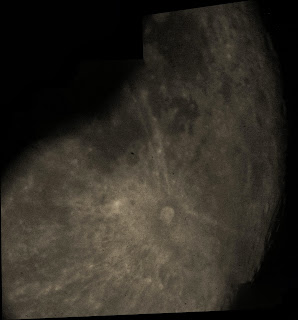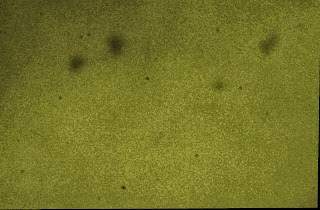October 2013
Oct 30th 1530 GMT
I bin scanned the Sun mid afternoon through cloud but still
the sunspot patterns were quite easy to see.
Oct 29th 2040 GMT
I took a few frames of Perseus and stacked the best 12 of 13.While operating the camera, I saw a meteor (probably sporadic) flashing south from Aries. I also scanned a few objects with my binoculars. The Pleiades and Hyades looked great and the Andromeda Galaxy showed its full extent and even a dust lane. The Perseus Double Cluster, M34 and Melotte 111 showed very well and I could see M36, M37 and M38 in Auriga, even though they were far from their best. The Pinwheel Galaxy was barely visible whilst M81 and M82 were not visible at all.
Oct 29th 1100 GMT
I bin scanned the Sun in a clear sky and saw that the sunspot pattern had changed.
Oct 27th 1040 GMT
I saw the Moon high in the west at a thick waning crescent
phase. Only Kepler was showing rays and there were few southern craters
visible. Like the previous day, Grimaldi showed well, due to libration.
The Sun continued to be active.
Oct 26th 2240 GMT
After heavy rain, it was very clear after Match of the Day,
so I went out armed with a camera. I had another go at snapping Jupiter’s moons
and then took a few frames of the Hyades. I made a further attempt at Cetus,
having captured Pisces on a previous occasion. I ended up with Gemini,
featuring Jupiter. I was about to tackle Orion and the great nebula (M42) when
cloud moved in from the north and west.
The Hyades shot was an improvement from the previous night.
The Cetus shot was affected by haze but I managed to isolate the shape of the constellations.
Only one exposure of Jupiter and Gemini worked, as the others were ruined by cloud.
While waiting for some longer exposures, I bin scanned the
Hyades, Pleaides and Orion Great Nebula, all producing very good results.
Oct 26th 0100 GMT
It was cloudy but had cleared somewhat since earlier in the
evening but I was feeling rather tired, so didn’t feel like carrying a
telescope out. Instead I took out my DSLR and attempted the Moon with Jupiter,
the Moon on its own and Jupiter (hoping to catch some moons). I also took some
close-up (75mm) exposures of the Pleiades (M45) and Hyades.
The Moon with Jupiter shot also showed some stars in Gemini.
The Moon on its own just showed the phase and maria and I didn't capture any of Jupiter's moons.
I stacked two Pleiades frames to get this:
... and finally the Hyades.
Click here if it appears blank: http://s197.photobucket.com/user/PhillipPugh/media/HyadesY13OctD26_zps58da0a37.jpg.html?sort=3&o=1
Oct 25th 1035 GMT
I saw a last quarter Moon, still quite high in the west. Clavius was just about visible near the terminator. Tycho's rays were gone but those of Copernicus and Kepler dominated the moonscape. Grimaldi was relatively away from the limb, due to libration, and showed well.The Sun was still active, with a new sunspot having formed or (more likely) rotated on.
Oct 24th 1005 GMT
The conditions were more hazy than the day before but there was no thick cloud around. However, I did not see as much sunspot detail as the day before.Oct 23rd 2115 GMT
I was ready to do a photo shoot of Perseus but found it was cloudy in that area, so I did a single frame of the Plough before it clouded out there as well.Perseus was still cloudy, so I shot Cygnus and caught Lyra, Delphinus and part of Aquila in the six frames.
I managed 8 frames of Perseus and ended up with this:
Finally 13 frames of the Moon at 70mm.
Oct 23rd 1020 GMT
There was a lot of moving cloud about but I was able to get a good look at the Sun and the sunspot patterns were really quite amazing.Oct 22nd
I reprocessed another solar hydrogen alpha photo from September 28th 2011.Oct 21st
I reprocessed a solar hydrogen alpha photo from September 28th 2011.Oct 19th 1350 GMT
A mid-afternoon binocular scan revealed 3 sunspots.Oct 17th 2110 GMT
Oct 17th 1220 GMT
I bin scanned the Sun at lunchtime and found the sunspots I
had seen the day before had changed shape and were about to rotate off.

Oct 16th 1440 GMT
I bin scanned the Sun mid-afternoon and found two sunspots
near the western limb.
Oct 13th 2130 GMT
Conditions were poor but I managed some lunar action between the clouds. The Moon was waxing gibbous and Clavius and the surrounding area looked great.
Unfortunately, all of the images were blurred.
October 12th 1555 GMT
The Sun was relatively quiet in hydrogen alpha light apart from around the sunspots and I had trouble getting pictures. I was only able to get a prominence on "film".
Oct 12th 1540 GMT
The Sun was very active in white light as I took several frames of full disc and close ups using the Mak and DSLR. Only one close-up produced a result.
Oct 10th 1115 GMT
The sun was very active in white light with lots of sunspots. I took several images with my Mak and DSLR but only ended up with 2 usable results.
Oct 9th 2015 GMT
I took some frames of the Perseus double cluster at ISO3200 with 15 secs exposure. I repeated the exercise with M45 (Pleiades) then took various exposures of Draco. Although I saw a mag 0 meteor it did not register on the frame. Only the Draco shots produced anything useful but I was quite pleased with the result.
Oct 6th 1750 GMT
I
spotted Venus with my binoculars, so was out soon after doing a webcam shoot.
Phase seemed about 65-70%.
Oct 6th 0920 GMT
I
did an extensive photo shoot of the Sun in white light with my Maksutov and
hydrogen alpha with my PST. There were just two sunspots readily visible and
most of the action in hydrogen alpha was concentrated in the same area. I also
saw some small prominences but wasn’t sure whether they would photograph.
Oct 6th 0000 GMT
I went out again later and using the same technique that I’d used before snapped the Hyades.
I also snapped Mizar and Alcor but the image lacked focus.
7 of 11 Pisces frames stacked to produce this image.
http://s197.photobucket.com/user/PhillipPugh/media/PiscesY13OctD06_zps897e15bd.jpg.html?sort=3&o=0
I then processed a stacked image of Taurus:
http://s197.photobucket.com/user/PhillipPugh/media/TaurusY13OctD06_zps5269a3b3.jpg.html?sort=3&o=0
The final shot of the session was Auriga.
http://s197.photobucket.com/user/PhillipPugh/media/AurigaY13OctD06_zps7c916936.jpg.html?sort=3&o=0
I made audacious attempts to capture Cetus and Pisces and ended up with Taurus and Auriga.
While watching, I saw 3 sporadic meteors (not bad as I was spending some time operating the camera and can only see a third of the sky when I am paying attention). The first would have been a Perseid and was about magnitude 1. The second came through Taurus from Cetus and was much fainter at mag. 4. The final one took a similar path and was about mag. -3 and was brighter than Jupiter, which had just about cleared the houses.
Oct 5th 2100 GMT
After a cloudy day, I went out to do a photo shoot. My main target was Aquarius, which wasn't a great success and I also snapped Cygnus. Delphinus crept into both fields of view. If you are having trouble viewing the images, please click on the link below them:http://s197.photobucket.com/user/PhillipPugh/media/CygnusLyraDelphinusY13OctD05_zps44109eee.jpg.html?sort=3&o=0
I then tried an experiment and took some shots of Melotte 20 and the Pleiades (M45) at 70mm with 10 seconds exposure at ISO 3200.
 |
| http://s197.photobucket.com/user/PhillipPugh/media/Melotte20Y13OctD05_zpsf90843e6.jpg.html?sort=3&o=3 |
http://s197.photobucket.com/user/PhillipPugh/media/M45Y13OctD05_zps6b850871.jpg.html?sort=3&o=1
Oct 4th 2110 GMT
I went out with my DSLR and binoculars and started with both to the west taking several 30 second exposures of Aries and Triangulum. I bin scanned the area, starting with Melotte 20, which is also good for focusing instruments. Yes, it was good and so was the Perseus Double Cluster. M34 showed well, as did the Andromeda Galaxy (M31). I could also see the Pinwheel (M33). I could see the Pleiades (M45) which showed rather nicely. I even saw M36, M37 and M38 at the lowest elevation I ever have and could just see the Hyades before cloud moved in.Not only did I get Aries and Triangulum but Perseus and Andromeda were in the same frame.
I switched my attention to the pole, where I took a 2 minute exposure when cloud moved in again.
An attempt at Hercules didn’t do much but I did see the Wild Duck Cluster (M11) and the 2 globular clusters in Hercules M13 and M92.




















































